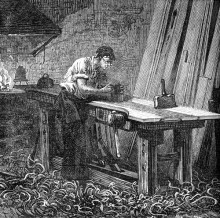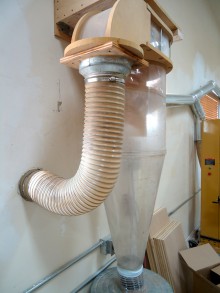The Many Hats of a Woodworker
Article - April 10, 2012
What does it mean to be a woodworker? Most would probably agree that at the most basic level, a woodworker is one who uses tools to shape objects out of wood. Fair enough. But today’s modern woodworker has to be so much more than that. Some of this is self-inflicted punishment for “needing” the latest and greatest gadgets, but even a modest modern hobbyist wood shop requires the owner to wear many hats in order to be successful and productive. I imagine this might be at the heart of the rude awakening most new woodworkers experience when first entering the craft and it probably creates a sizable barrier to entry as well. Perhaps just talking about these things and sharing ideas will help us devise solutions, work-arounds, and maybe even some reality checks that will make the process of becoming a woodworker much easier.
The Traditional Joiner
 If you are into hand tools, not only do you need to learn how to use the tools but also tune and sharpen them. How many of us toiled away for months or longer trying to figure out how to use a plane that was never sharpened properly? I remember vividly the first time I took a few strokes with a friends finely-tuned smoother. What an epiphany! I felt like such a goober because I always blamed my poor results on my lack of skills. I honestly never suspected that the tool itself was at the heart of the issue. No wonder it chewed up my work like a Labrador puppy!
If you are into hand tools, not only do you need to learn how to use the tools but also tune and sharpen them. How many of us toiled away for months or longer trying to figure out how to use a plane that was never sharpened properly? I remember vividly the first time I took a few strokes with a friends finely-tuned smoother. What an epiphany! I felt like such a goober because I always blamed my poor results on my lack of skills. I honestly never suspected that the tool itself was at the heart of the issue. No wonder it chewed up my work like a Labrador puppy!
If you’re using Grandpa’s old tools or some flea-market finds, you’ll need to become fairly competent at tool rehabilitation too. The sharpest iron in the world won’t help you if the sole is shaped like a banana. Just ask my buddy Matt Vanderlist.
The Machinist
 If you choose to incorporate power tools into your shop, you now need to learn the ins and outs of tool setup and calibration. If you think you can un-crate that shiny new tablesaw, plug it in, and be on your way to wood-cutting bliss, think again! Every tool needs to be calibrated properly before use. Taking measurements down to the nearest thousandth is common practice (sometimes unnecessarily) and for those of us with failing eyesight, that’s never any fun!
If you choose to incorporate power tools into your shop, you now need to learn the ins and outs of tool setup and calibration. If you think you can un-crate that shiny new tablesaw, plug it in, and be on your way to wood-cutting bliss, think again! Every tool needs to be calibrated properly before use. Taking measurements down to the nearest thousandth is common practice (sometimes unnecessarily) and for those of us with failing eyesight, that’s never any fun!
Once the tool is up and running, of course you need to learn how to use it. While most power tools don’t require the same manual dexterity as their hand tool counterparts, there is certainly some nuance to it. Tools like the tablesaw and jointer require much more in the way of body movement than simply “passing the wood over/through the blade”.
The Safety Officer
 Regardless of which tools you use, safety must be the number one priority. Learning to work safely is not quite as easy as simply reading a manual or watching a basic instructional video. What you need is time: time to familiarize yourself with the normal operation of the tool, time to gain enough experience to be able to identify abnormal tool operation, and time to use the tool in various ways in order to gain confidence in its many potential uses. Keep in mind that time does not automatically equate to increased safety. It’s how you spend that time that determines how often you put yourself at risk on a typical shop day. I have seen many “experienced” woodworkers doing very stupid things with tools.
Regardless of which tools you use, safety must be the number one priority. Learning to work safely is not quite as easy as simply reading a manual or watching a basic instructional video. What you need is time: time to familiarize yourself with the normal operation of the tool, time to gain enough experience to be able to identify abnormal tool operation, and time to use the tool in various ways in order to gain confidence in its many potential uses. Keep in mind that time does not automatically equate to increased safety. It’s how you spend that time that determines how often you put yourself at risk on a typical shop day. I have seen many “experienced” woodworkers doing very stupid things with tools.
The Finisher
 Once you are comfortable with your tools and you begin cranking out projects, you eventually realize you need to educate yourself on finishing. If that isn’t a can of worms, I don’t know what is! In my opinion, finishing is one of the most needlessly over-complicated areas of woodworking. That’s exactly why I wrote a book in an effort to simplify things for the newbie. “What type of finish should I use on my project?” is the most common question to hit my inbox, and for good reason. There are so many choices out there and they all promise you the world! Fortunately, this is one area where you can truly keep things simple and not sacrifice the quality of your work. Don’t get caught up in the marketing hype and don’t be tempted to try a new finish on every project. Pick a finish that initially appeals to you and take the time to become skillful at applying it.
Once you are comfortable with your tools and you begin cranking out projects, you eventually realize you need to educate yourself on finishing. If that isn’t a can of worms, I don’t know what is! In my opinion, finishing is one of the most needlessly over-complicated areas of woodworking. That’s exactly why I wrote a book in an effort to simplify things for the newbie. “What type of finish should I use on my project?” is the most common question to hit my inbox, and for good reason. There are so many choices out there and they all promise you the world! Fortunately, this is one area where you can truly keep things simple and not sacrifice the quality of your work. Don’t get caught up in the marketing hype and don’t be tempted to try a new finish on every project. Pick a finish that initially appeals to you and take the time to become skillful at applying it.
The Electrician
 How about the workshop itself? Once you start to get into the more beefy tools, you no doubt will require 220v power. If you are somewhat comfortable with basic home wiring and you’re cheap like me, you will most likely tackle this work yourself. Whether you should or shouldn’t might be the subject of a different article in the future. Aside from new outlets, you probably want more lighting too. Who doesn’t?! So you may as well run an extra circuit or at least extend the current one. What gauge wire should you use? Should you use romex? Should you tap into the old drier outlet for easy 220? How many wires can you safely fit into 1/2″ conduit? These are all questions that I used to wrestle with until I wised up and called in a professional. Unless you have a background in electrical work, the cost of hiring a professional electrician is well worth it if you can rest easy knowing you won’t inadvertently burn your house down.
How about the workshop itself? Once you start to get into the more beefy tools, you no doubt will require 220v power. If you are somewhat comfortable with basic home wiring and you’re cheap like me, you will most likely tackle this work yourself. Whether you should or shouldn’t might be the subject of a different article in the future. Aside from new outlets, you probably want more lighting too. Who doesn’t?! So you may as well run an extra circuit or at least extend the current one. What gauge wire should you use? Should you use romex? Should you tap into the old drier outlet for easy 220? How many wires can you safely fit into 1/2″ conduit? These are all questions that I used to wrestle with until I wised up and called in a professional. Unless you have a background in electrical work, the cost of hiring a professional electrician is well worth it if you can rest easy knowing you won’t inadvertently burn your house down.
The HVAC Specialist
 I was standing in my shop recently pondering my dust collection system. My ductwork needs some serious help and I couldn’t help but think, “I should hire someone to do this!”. As long as I’ve been doing woodworking, I still make major mistakes when it comes to designing an efficient system. I’ve read articles, blogs, and books, and I still screw it up. It should be simple right? Hook up the sucky thing to the stuff thank makes dust and you’re off to the races. Unfortunately, its just not that simple. Each tool has its own required CFM (cubic feet per minute) rating and you need to calculate the air movement and how much pressure you lose with your various drops. You then need to install the ductwork with minimal leakage as well as minimal twists and turns. To make matters worse, researching dust collection will make your head spin within minutes of hitting the enter key.
I was standing in my shop recently pondering my dust collection system. My ductwork needs some serious help and I couldn’t help but think, “I should hire someone to do this!”. As long as I’ve been doing woodworking, I still make major mistakes when it comes to designing an efficient system. I’ve read articles, blogs, and books, and I still screw it up. It should be simple right? Hook up the sucky thing to the stuff thank makes dust and you’re off to the races. Unfortunately, its just not that simple. Each tool has its own required CFM (cubic feet per minute) rating and you need to calculate the air movement and how much pressure you lose with your various drops. You then need to install the ductwork with minimal leakage as well as minimal twists and turns. To make matters worse, researching dust collection will make your head spin within minutes of hitting the enter key.
Ahhh! I just want to be a WOODWORKER!!
I’m not bringing all this up to discourage budding woodworkers. Quite the opposite in fact. Consider it a form of commiseration, if you will. We’ve all been there before. If we’re not puzzling over some complicated woodworking technique, we’re trying to figure out ways to improve the shop. As people who build furniture instead of buying it, I believe it’s in our nature to want to do everything ourselves. But frankly, it’s a little silly for us to think that we can master all of these aspects of running a shop.
Becoming a productive and functional woodworker, even at the hobbyist level, is quite an accomplishment. So if you’re new to the craft and you feel overwhelmed, remember that most of the folks you hear from have been at it for quite some time. Eventually, much of this information will find its way into your brain whether you want it there or not. And keep in mind, it never hurts to call in a professional when you aren’t sure about something (especially electricity).
I should also mention that simplifying your tool collection will go a long way in reducing the learning curve. If you decide to favor hand tools, you pretty much knock out electricity and dust collection from your list of crap to worry about.
I know we have lots of experienced woodworkers in the community and I’d like to hear what advice you might have for the folks just coming into the craft. What did you do to make the whole “becoming a woodworker” thing easier?



